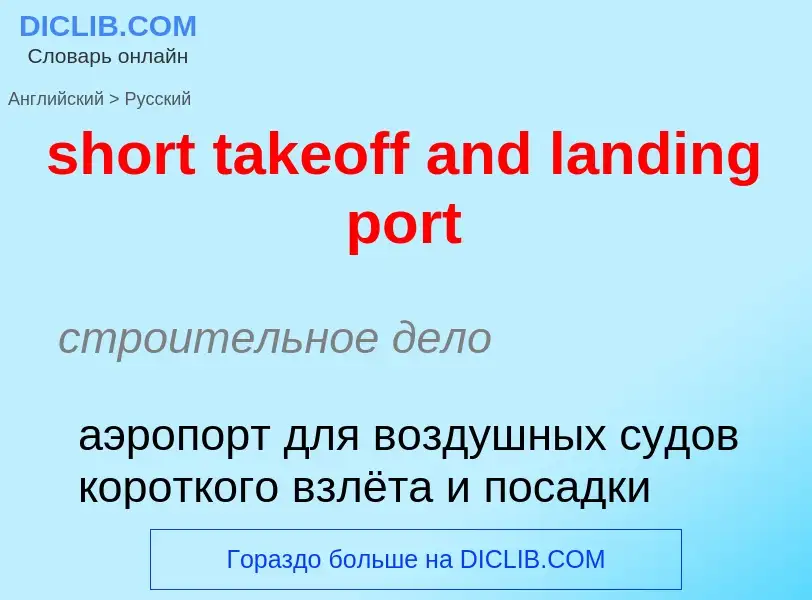Перевод и анализ слов искусственным интеллектом ChatGPT
На этой странице Вы можете получить подробный анализ слова или словосочетания, произведенный с помощью лучшей на сегодняшний день технологии искусственного интеллекта:
- как употребляется слово
- частота употребления
- используется оно чаще в устной или письменной речи
- варианты перевода слова
- примеры употребления (несколько фраз с переводом)
- этимология
short takeoff and landing port - перевод на русский
строительное дело
аэропорт для воздушных судов короткого взлёта и посадки
['dʒʌmpdʒet]
общая лексика
джамп-джет (разговорное название истребителя "Харриер" [Harrier])
дословная передача
реактивный самолёт-прыгун
существительное
общая лексика
реактивный самолет с вертикальным взлетом и вертикальной посадкой
существительное
авиация
вертикальный взлет и посадка
синоним
общая лексика
вертикальная посадка
общая лексика
посадка с немедленным взлетом
общая лексика
десантные войска
Определение
Википедия

A vertical and/or short take-off and landing (V/STOL) aircraft is an airplane able to take-off or land vertically or on short runways. Vertical takeoff and landing (VTOL) aircraft are a subset of V/STOL craft that do not require runways at all. Generally, a V/STOL aircraft needs to be able to hover. Helicopters are not considered under the V/STOL classification as the classification is only used for aeroplanes, aircraft that achieve lift (force) in forward flight by planing the air, thereby achieving speed and fuel efficiency that is typically greater than the capability of helicopters.
Most V/STOL aircraft types were experiments or outright failures from the 1950s to 1970s. V/STOL aircraft types that have been produced in large numbers include the F-35B Lightning II, Harrier, Yak-38 Forger and V-22 Osprey.
A rolling takeoff, sometimes with a ramp (ski-jump), reduces the amount of thrust required to lift an aircraft from the ground (compared with vertical takeoff), and hence increases the payload and range that can be achieved for a given thrust. For instance, the Harrier is incapable of taking off vertically with full weapons and fuel load. Hence V/STOL aircraft generally use a runway if it is available. I.e. short takeoff and vertical landing (STOVL) or conventional takeoff and landing (CTOL) operation is preferred to VTOL operation.
V/STOL was developed to allow fast jets to be operated from clearings in forests, from very short runways, and from small aircraft carriers that would previously only have been able to carry helicopters.
The main advantage of V/STOL aircraft is closer basing to the enemy, which reduces response time and tanker support requirements. In the case of the Falklands War, it also permitted high-performance fighter air cover and ground attack without a large aircraft carrier equipped with aircraft catapult.

![[[RAF]] Harrier GR9 arrives at [[RIAT]] 2008 [[RAF]] Harrier GR9 arrives at [[RIAT]] 2008](https://commons.wikimedia.org/wiki/Special:FilePath/BAe Harrier GR9 ZG502 landing arp.jpg?width=200)
![MV-22 Osprey]] prepares to land aboard a ship MV-22 Osprey]] prepares to land aboard a ship](https://commons.wikimedia.org/wiki/Special:FilePath/US Navy 080220-N-5180F-015 A Marine Corps MV-22 Osprey prepares to land aboard the amphibious assault ship USS Nassau (LHA 4).jpg?width=200)
![U.S. Marines jump from a [[Bell-Boeing V-22 Osprey]], the first production [[tiltrotor]] aircraft U.S. Marines jump from a [[Bell-Boeing V-22 Osprey]], the first production [[tiltrotor]] aircraft](https://commons.wikimedia.org/wiki/Special:FilePath/Aircraft.osprey.678pix.jpg?width=200)
![VJ101]] on display at the [[Deutsches Museum]], [[Munich, Germany]] VJ101]] on display at the [[Deutsches Museum]], [[Munich, Germany]]](https://commons.wikimedia.org/wiki/Special:FilePath/Aircraft VJ101C top.jpg?width=200)
![Canadair CL-84 Dynavert CL-84-1 (''CX8402'') on display at the [[Canada Aviation and Space Museum]] in Ottawa, Ontario Canadair CL-84 Dynavert CL-84-1 (''CX8402'') on display at the [[Canada Aviation and Space Museum]] in Ottawa, Ontario](https://commons.wikimedia.org/wiki/Special:FilePath/CanadairCL-84DynavertSerialCX8402.jpg?width=200)

![Do 31 E3]] on display at the [[Deutsches Museum]], Germany Do 31 E3]] on display at the [[Deutsches Museum]], Germany](https://commons.wikimedia.org/wiki/Special:FilePath/Do-31 2.jpg?width=200)



![A [[Schiebel Camcopter S-100]], a modern VTOL [[unmanned aerial vehicle]] A [[Schiebel Camcopter S-100]], a modern VTOL [[unmanned aerial vehicle]]](https://commons.wikimedia.org/wiki/Special:FilePath/Schiebel CAMCOPTER S-100.jpg?width=200)



![[[DC-XA]] landing in 1996 [[DC-XA]] landing in 1996](https://commons.wikimedia.org/wiki/Special:FilePath/DC-XA first landing.jpg?width=200)
.jpg?width=200)

![Ronald Reagan}} during [[Gringo-Gaucho]] joint US-Argentine manoeuvres. Ronald Reagan}} during [[Gringo-Gaucho]] joint US-Argentine manoeuvres.](https://commons.wikimedia.org/wiki/Special:FilePath/Argentine Navy Dassault Super Etendard jet on USS Ronald Reagan.jpg?width=200)

